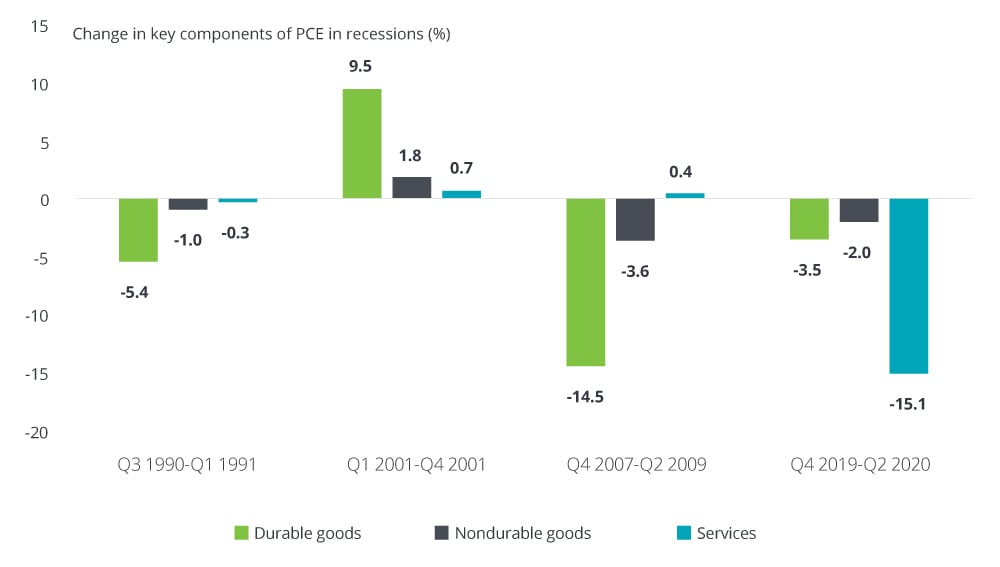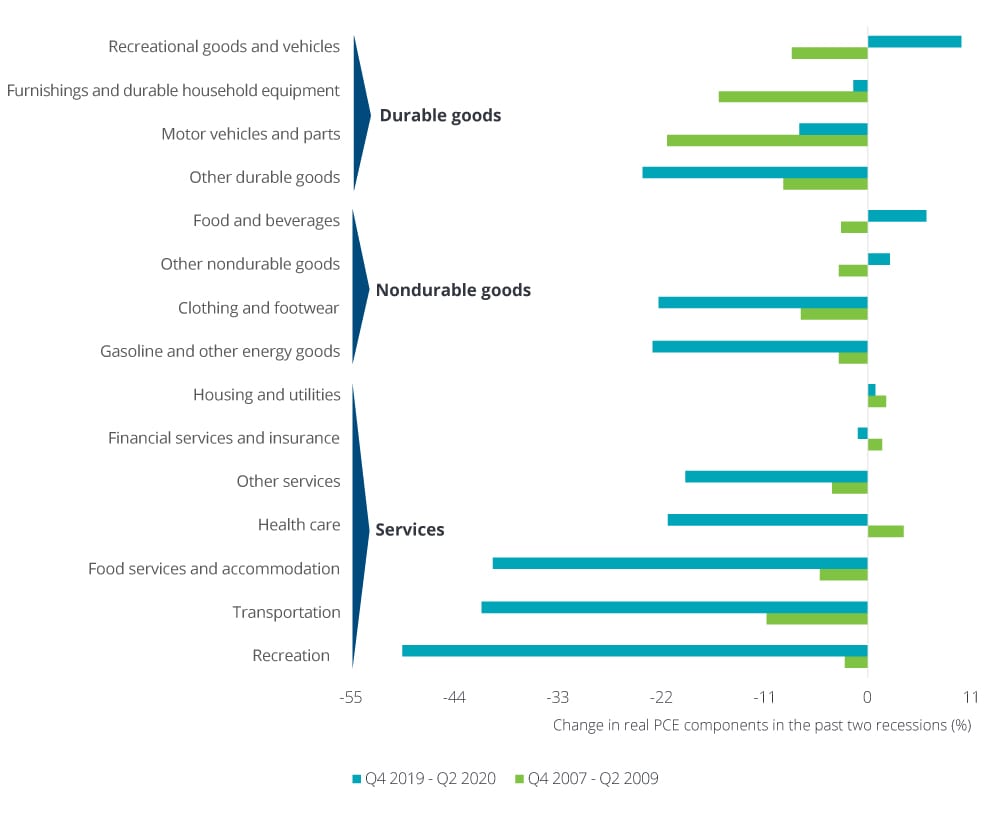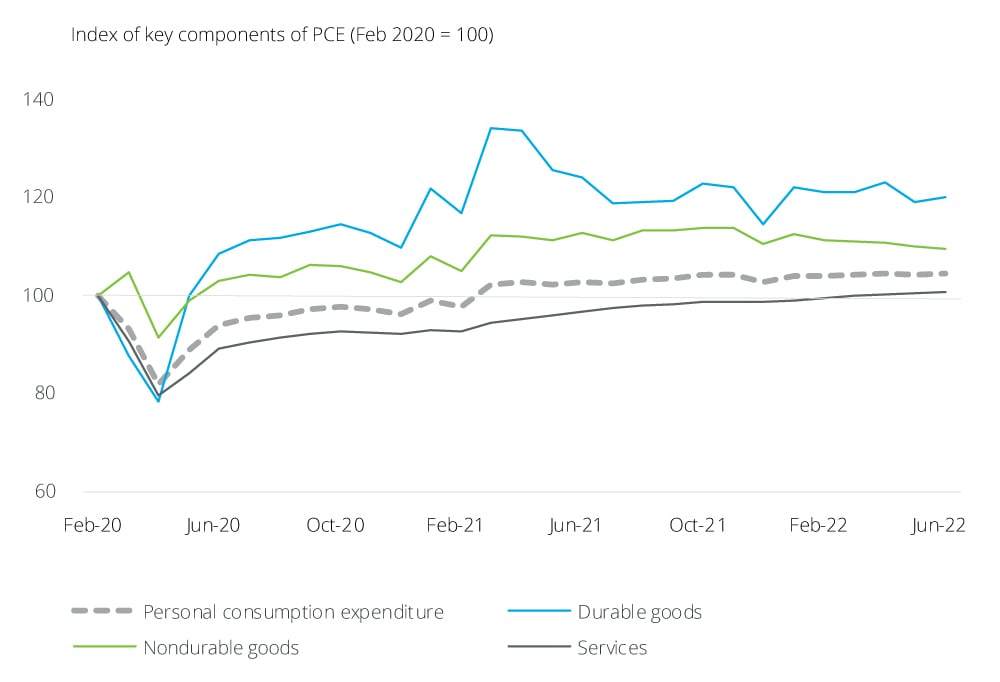Services favored as recession clouds hover has been saved
Perspectives
Services favored as recession clouds hover
The impact of recession on consumer spending
Will the US slip into recession in 2022-2023? If so, consumer spending will be impacted and so will wider economic activity. Real personal consumption expenditure (PCE) accounts for more than two-thirds of GDP, and PCE has fallen throughout or at different times during all recessions in the last 60 years, except for the one in 2001. A recession in the near term will also bear the mark of COVID-19, for any downturn will happen at a time when the pandemic-era focus on goods, especially durable goods, is slowly giving way to a resurgence in consumer spending on services.
Explore content
- The outlook for consumer spending in a recession
- Durables are usually the worst hit, but the COVID-19 recession had a twist
- A recession in 2022–2023 will still bear the mark of the pandemic
- For durable goods, a recession will be a double whammy
- Endnotes
The outlook for consumer spending in a recession
Consumer spending on durable goods typically bears the brunt of any recession.1 That’s hardly surprising given that people tend to postpone large purchases such as expensive household goods or cars when the economic outlook is grim. In 2020, however, things were very different. Spending on services, not durables, were hit the hardest. For unlike previous recessions, it was not any economic or financial factor but a virus that forced economic activity down sharply in the first half of 2020. The pandemic’s impact will be felt again if the economy slips into a recession in 2022–2023. In such a scenario, services spending will still have the tailwinds of a shift in consumer spending to services in its favor, but PCE on durable goods will contract this year and the next.2
Durables are usually the worst hit, but the COVID-19 recession had a twist
Spending on durable goods—a segment that includes automobiles, furnishings, and recreational goods among others—is usually hit more during recessions than spending on nondurable goods. After all, people spend on groceries even during a downturn, but plans to buy expensive goods such as cars can be pushed to a later day. PCE on motor vehicles and parts, for example, fell by 21.3% in the recession of Q4 2007 to Q2 2009, a much steeper fall than the 2.9% decline in food and beverages purchased for off-premises consumption during the same period. Services were even less impacted, with spending during this period growing by 0.2% (Figure 1).
The last recession, however, had a different underlying element—a public health emergency. As COVID-19 spread, so did social distancing restrictions and fears about contracting the virus. Heading to the local pub, hailing a taxi, or hitting the gym, which were the norm in a pre-pandemic world, suddenly stopped as people hunkered down indoors. Instead, remote work took over for many and spending on home offices and personal gym equipment went up. Consequently, spending on services fared much worse in the last recession compared to the one before: PCE on services contracted 15.1% between Q4 2019 and Q2 2020, much higher than the 3.5% decline in spending on durable goods. In fact, the decline in PCE on durables in the last recession was the least among all recessions since 1953.
Figure 1. PCE on services dropped sharply in the recession of 2020 as the virus kept people indoors

Note: The data is seasonally adjusted.
Sources: Bureau of Economic Analysis (sourced through Haver Analytics); Deloitte Services LP economic analysis.
Figure 2 shows the difference in the nature and scale of impact of the last two recessions on consumer spending categories. Recreation services, which is typically discretionary spending, does take a hit during recessions, but the 49.4% drop in spending between Q4 2019 and Q2 2020 is typical of the pandemic-induced hit to all activities where social distancing is difficult. Spending on food services, accommodation, and transportation show a similar trend. Even healthcare spending, which normally does not show any cyclical trend, suffered as people and hospitals postponed visits for non-emergency care during the pandemic.
Figure 2. The nature and degree of impact of the past two recessions on PCE differ greatly

Note: The data is seasonally adjusted.
Sources: Bureau of Economic Analysis (sourced through Haver Analytics); Deloitte Services LP economic analysis.
A recession in 2022–2023 will still bear the mark of the pandemic
Any recession this year or the next will take place on the backdrop of two key trends. First, consumer spending on services has been picking up steadily as consumers flock back to pubs and restaurants, spend on travel and leisure, and enjoy sporting events as they did before the pandemic. Pent-up demand is also playing a part as consumers dip into their savings to make up for all the activities they missed in 2020–2021. By contrast, durable goods, the mainstay of consumer spending in 2020, is losing its shine (Figure 3). After all, unlike a family vacation or a baseball game, there’s a limit to the amount of gym equipment or cars a consumer can buy.
Figure 3. As the pandemic eases, PCE on services is slowly gaining at the expense of goods

Note: The data is seasonally adjusted.
Sources: Bureau of Economic Analysis (sourced through Haver Analytics); Deloitte Services LP economic analysis.
Second, inflation3 is denting consumers’ purchasing power despite gains in nominal income due to a strong labor market. Real average weekly earnings have fallen by 4.7% since December 2020 despite a 7.5% rise in nominal earnings during this period.4 Rising inflation is weighing on consumer sentiment. Deloitte’s survey of consumers shows that the share of respondents who intend to delay large purchases has been steadily going up since mid-2021 to 56% in June.5 The same survey shows that worries about savings have gone up, too6, hardly surprising given that the personal saving rate (5.1% in June) is lower than pre-COVID levels.
For durable goods, a recession will be a double whammy
Given the backdrop of high inflation, a shift in consumer spending to services, and slowing economic growth, durable goods are already under pressure compared to 2021. Deloitte economists in their baseline scenario, which doesn’t include a recession, expect consumer spending on durable goods to contract this year and the next before recovering in 2024.7 A recession will only make this worse. In that scenario, which has a 30% probability, the contraction in spending on durables this year and the next will be more (-1.3% each year) and the recovery in 2024 much slower. Spending on non-durable goods is also expected to follow a similar trajectory. In contrast, services spending will have tailwinds in its favor even during a recession: As spending on durables and nondurable falter, PCE on services is expected to expand by 4.3% in 2022 and by 2.1% in 2023.
Things may worsen if inflation turns out to be stickier, prompting the Federal Reserve to expand the degree and scope of its monetary response. Consumers will, however, be hoping that won’t be the case and that any recession is short and mild.
Endnotes
1 Akrur Barua, “What might be expected of consumer spending in a COVID-19-driven business cycle?” Deloitte Insights, April 29, 2020.
2 Daniel Bachman, “United States Economic Forecasts: Q3 2022,” Deloitte Insights, to be published soon. The Q3 forecasts put a probability of 30% to a recession. All forecast data in this section is from this source.
3 Bureau of Labor Statistics, Consumer Price Index, sourced through Haver Analytics in August 2022.
4 Bureau of Labor Statistics, Establishment Survey, sourced through Haver Analytics in August 2022.
5 Deloitte Global State of the Consumer Tracker, accessed in August 2022.
6 Ibid.
7 Daniel Bachman, “United States Economic Forecasts: Q3 2022,” Deloitte Insights, to be published soon. The Q3 forecasts put a probability of 30% to a recession. All forecast data in this section is from this source.
Get in touch
 |
||||
 |
Akrur Barua |
|||
Recommendations
What might be expected of consumer spending in a COVID-19-driven business cycle?
With the COVID-19 pandemic likely to trigger a recession in the United States, consumer spending is expected to take a downturn.
A spring in consumers’ steps: Americans prepare to get back to their spending ways
With the US economy slowly returning to prepandemic levels, consumer spending is likely to get a shot in the arm as consumers eagerly spend on activities that had screeched to a halt during the COVID-19 pandemic.


